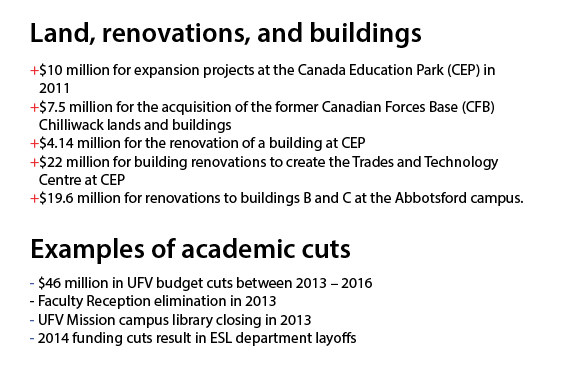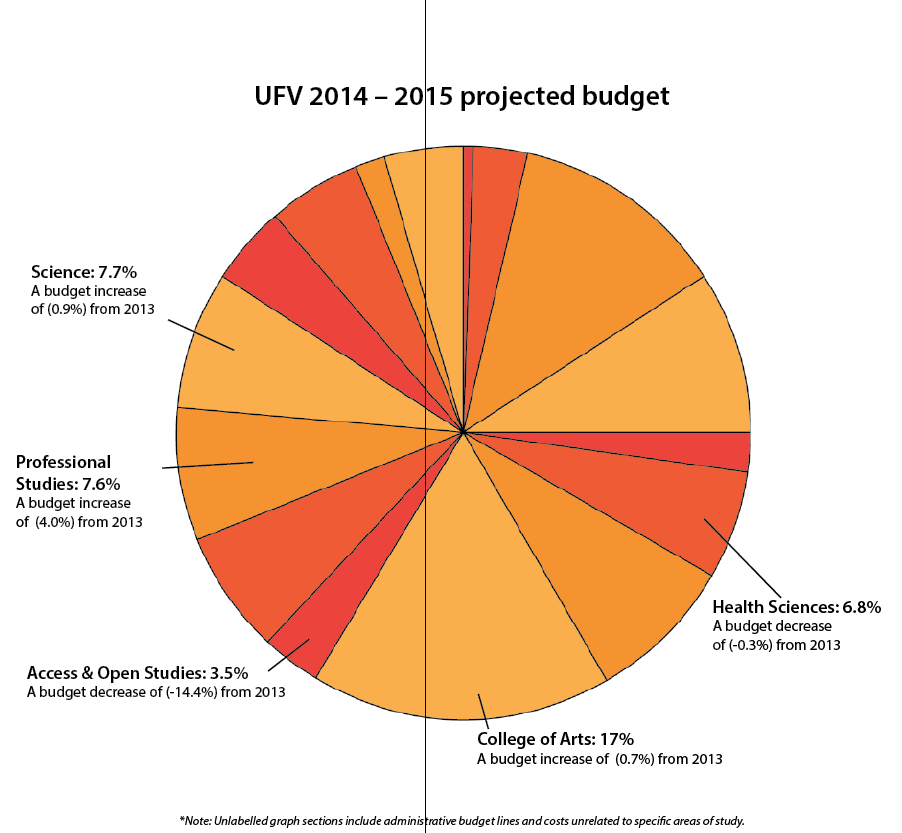Print Edition: October 1, 2014
Philosophy and poetry have never been big priorities for government spending. So when funding cuts or gifts come to the university’s door, there is a significant impact on an institution’s priorities.
UFV, for example, has recently accepted $872,000 from a provincial program called the BC Skills for Jobs Blueprint — part of the government’s $6.8 million investment in trades training. $807,000 of this funding goes toward opening 194 new training spaces for potential welders, carpenters, and electricians, while $65,000 goes towards equipment costs.
According to UFV’s 2014-15 final budget plan, the Ministry of Education identifies “aligning post-secondary education training and programs with labour market demand to achieve a highly skilled workforce” as one of its strategic objectives.
[pullquote]By 2017, the government expects to reallocate 25 per cent of its post-secondary operating budgets on programs that lead to … high-demand jobs.[/pullquote]
Proponents also cite unemployment as an issue that an emphasis on job-specific education will seek to solve. The phrase “turning learners to earners” is the mantra of this movement for those selling the idea of job-specific education to the public, while other reports put a stronger emphasis on the point that positions will need filling.
The plan also aims to reform public K-12 education to highlight trades as a career path for students.
“We want students to find their fit earlier,” Peter Fassbender, minister of education, noted upon introducing the blueprint in April 2014. “Our goal, ultimately, is to give every student … a better, early head start on their future education.”
The blueprint says that “by 2022, there are expected to be a million job openings in British Columbia.” Meanwhile, UFV’s institutional accountability report and plan for 2014-2015 estimates a less drastic number of 61,500 workers needed for 2020. It emphasizes such areas of expansion as the liquefied national gas (LNG) development in Northern BC, and increased trade with Asia.
BC’s LNG industry is young, but the skills training a university offers for jobs related to it are a major factor in the blueprint’s funding allocations — likely due to the profitable international trade deals in the works. The government has also proposed to levy a seven per cent tax on LNG exports, but this number will not be finalized until later in the fall when the government has announced its fiscal plan for the industry.
By 2017, the government expects to reallocate 25 per cent of its post-secondary operating budgets to programs that lead to employment in what it deems as high-demand jobs. Besides this, UFV’s funding cuts will total $46 million between 2013 and 2016 — and has already had to shut down faculty reception in Abbotsford and the library at the Mission campus.
Hilary Turner, head of English, music, and linguistics at UFV, notes that there is now a greater willingness to cancel courses that do not approach a 100 per cent fill-rate — that is, courses which have too few students registered and therefore cost UFV.
On top of this, mandatory courses with high enrolment such as English 105 have increased their maximum enrolment — in English 105’s case, from 23 to 26. Although this allows more students the opportunity to sign up, it creates more labour for professors, whose salaries have not seen a corresponding increase.
UFV hasn’t cut entire programs in the arts so far, but the funding cuts across the board place priority on the areas of study offered to students. This also limits the amount of new instructors-for-hire, and means that sessional instructors cannot be certain that they will be hired again for the next year.
Without the opportunity to hire new people and expand programs that may not align with the provincial government’s economic priorities, specialized areas of a given subject (say, medievalism or the avant-garde in English) will no longer be available to students as instructors leave or retire. Turner reports that this has created a real climate of anxiety for UFV’s employees.
Turner says industry sectors are as changeable as any other sector in the economy, and focusing on specialized job training might prove short-sighted when the demand for jobs in those specialized areas dwindles in the long term.
A discussion concerning job-specific training in K-12 and post-secondary institutions is scheduled for October 15 in the north gym of the UFV Envision Centre.





